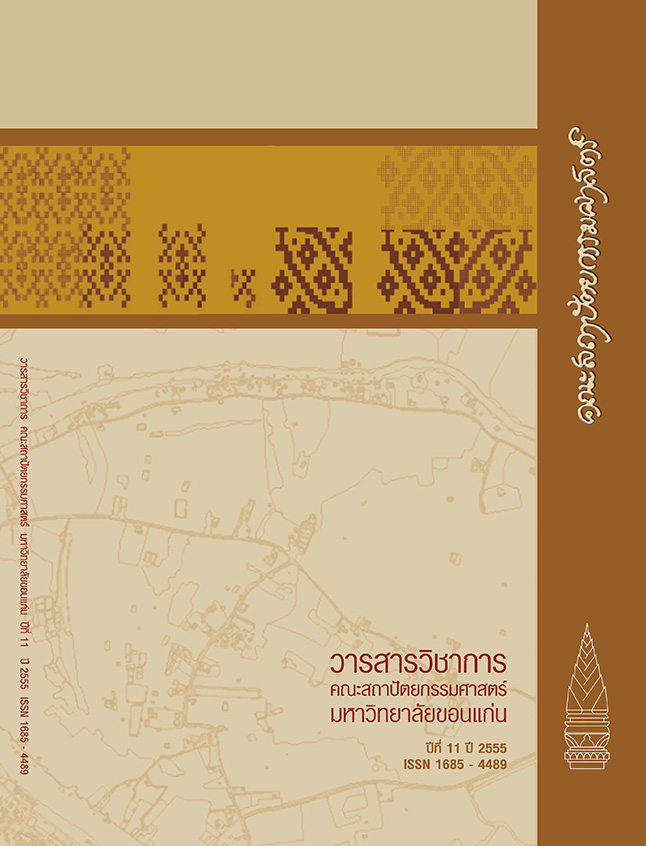แนวทางการจัดการขยะในแหล่งกำเนิดชุมชน เมืองอุดรธานี
คำสำคัญ:
-บทคัดย่อ
งานวิจัยนี้ มีวัตถุประสงค์เพื่อหาแนวทางการจัดการขยะในเขตเมืองอุดรธานี การศึกษา แบ่งแหล่งกำเนิดขยะแยกตามประเภทการใช้อาคาร 6 กลุ่ม คือ กลุ่มอาคารที่พักอาศัย กลุ่มอาคาร พาณิชยกรรม กลุ่มอาคารอุตสาหกรรม กลุ่มอาคารสถาบันราชการ กลุ่มอาคารสถาบันศาสนา และกลุ่มอาคารสถานศึกษา โดยแหล่งกำเนิดขยะทั้ง 6 แบ่งเป็น 27 ประเภท จากผลการศึกษา พบว่า ปริมาณขยะที่เกิดขึ้นในเขตผังเมืองรวมเมืองอุดรธานีในปี พ.ศ. 2550 มีปริมาณ 158 ตัน/ วัน คิดเป็นอัตราการเกิดขยะ 0.67 กก./คน/วัน ขยะรีไซเคิลมีสัดส่วนมากที่สุดถึง 46.22% รองลง มาคือขยะที่ย่อยสลายได้ 46.18%เมื่อแยกตามประเภทของแหล่งกำเนิดขยะพบว่า โรงพยาบาล มีอัตราการเกิดขยะสูงสุด คือ 1.87 กก./เตียง/วัน รองลงมาคือ อาคารอยู่อาศัยรวม มีค่า 1.62 กก./ห้อง/วัน ส่วนอาคารห้างสรรพสินค้าจะมีค่าอัตราการเกิดขยะตํ่าสุด คือ 0.03 กก./ตร.ม./วัน
สำหรับแนวทางในการจัดการขยะนั้น ได้เสนอแผนยุทธศาสตร์ในการจัดการขยะสำหรับ เมืองอุดรธานี โดยมุ่งเน้นให้มีการจัดการขยะ ณ แหล่งกำเนิดเป็นหลัก ซึ่งประกอบด้วยแผน ยุทธศาสตร์หลัก 3 แผนสำหรับแหล่งกำเนิดขยะ 3 ประเภท คือ แหล่งกำเนิดขยะ ประเภทชุมชน ประเภทพาณิชยกรรม และประเภทสถาบัน ซึ่งแผนและโครงการนำร่อง ทั้งหมดนี้ สามารถเห็นผลเป็นรูปธรรมชัดเจน และสามารถพัฒนาเป็นต้นแบบในการจัดการขยะ สำหรับพื้นที่อื่นหรือเมืองอื่นๆ ได้
On Site Solid Waste Management Guidelines for Udonthani Urban Area
The objectives of this study are to fi nd out guidelines of the solid waste management for Udonthani Urban Area (UUA). The sources of solid waste have been divided by types of building uses into 6 groups, which are residential building, commercial building, industrial building, institutional building, religional building and educational building. In 6 main groups have been studied in 27 types of activities. The amount of collecting waste in 2007 is 158 tons/day and the solid waste generation rate is 0.67 kg./capita/day. The main composition of collecting waste is recyclable waste and compostable waste those have been generated of 46.22% and 46.18%of total collecting waste. Dividing from types of activities have shown that the maximum value of solid waste generation rate are hospital and apartment (1.86 kg./bed/day and 1.62 kg./room/day respectively) while department store has the lowest solid waste generation rate (0.03 kg./m2/day).
The solid waste management guidelines for UUA are on onsite managing concept which have 3 strategic plans for 3 types of point source those are community source, commercial source and institute source. All of strategic plans and projects can develop to be the solid waste management prototype for other cities in the near future.
ดาวน์โหลด
รูปแบบการอ้างอิง
ฉบับ
ประเภทบทความ
สัญญาอนุญาต
ทัศนะและข้อคิดเห็นของบทความที่ปรากฏในวารสารฉบับนี้เป็นของผู้เขียนแต่ละท่าน ไม่ถือว่าเป็นทัศนะและความรับผิดชอบของกองบรรณาธิการ




